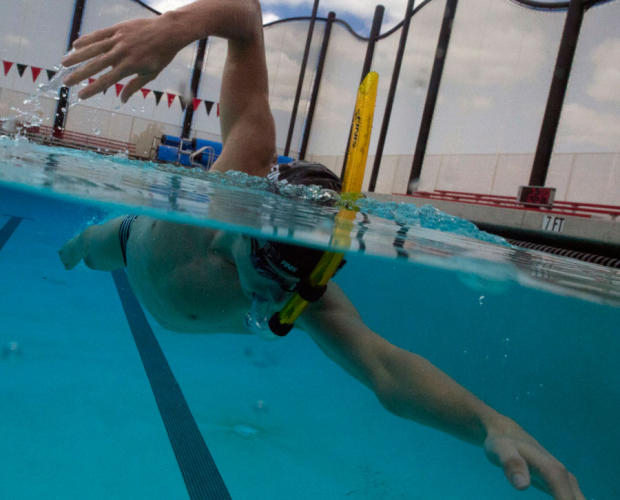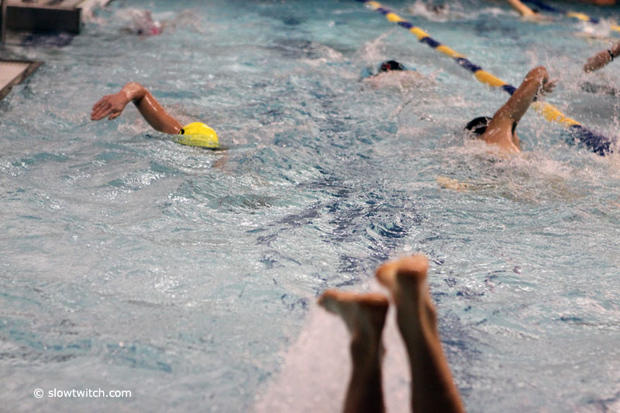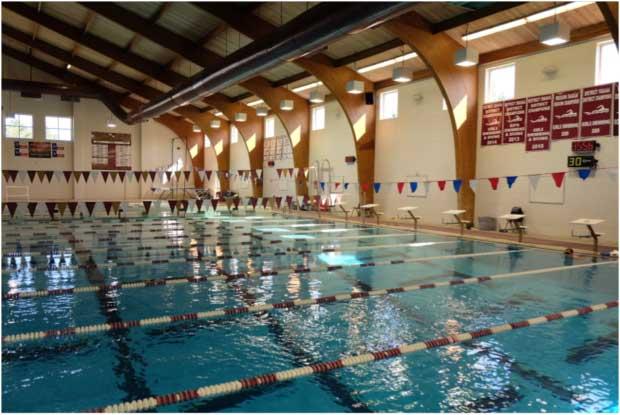Thoughts on Swimming
I swim master’s twice a week with a Triathlon focused group (Shout-Out to SBR in Verona, WI!), and I can always tell the newcomers from the more experienced swimmers right away. Not by speed, but by intent. Most Multi-sport athletes I’ve been around have a very driven attitude: Go and go hard. While I can certainly appreciate that, when you show up to the pool, maybe stop and look at what the experienced swimmers are doing.
You should strive to swim like a 12-year-old. Go watch a good club team practice. There’s playing and splashing; the kids are having fun (whether the coach wants them to or not). Before and between repeats and sets, there’s playing, splashing and bobbing, an innate comfort with the water. There’s a dedicated warm up that is swum at a warm-up pace – fast and hard takes time. But the work gets done too.
Equipment is used as a tool and not a crutch: Snorkels for alignment, kickboards and pull buoys for isolation of movements, paddles and fins for strengthening.

Before going anywhere, try to play in the pool. Get comfortable underwater: dive, shake and bob. Once you’re comfortable, it’s time to start focusing on how the base state of swimming is relaxation, with the application of tension. This column is going to focus on 3 key areas for the specific, and in my estimation most important, applications of tension: breathing, body position, and kicking.
The breath is the starting point for all swimming. When starting a series of lessons with a swimmer, whether kid or adult, beginner or expert, I always start with breathing. Breaths should be full, but relaxed. Sitting wherever you are reading this right now, try and take as big a breath as possible. Feel the tension in your lungs, feel it up the back of your neck, feel it in your throat. Now exhale. That was useless tension. Your lungs are a very helpful buoy when you’re swimming, but if you’re overfilling them, they’re going to hurt you. Now take full but comfortable breath. For 90% the amount of air, you have 10% the amount of tension. That’s the feeling you want.
Now the exhale. Breathe in; and let the air dribble out your nose. If you were in a pool doing this exercise you’d be sinking. Use your lungs to your advantage and keep them full until it’s time for an exchange. Breathe in, hold for a 3 count and blow out your nose with some force. You should feel a reflex to inhale almost right away. This is a good reflex, and one you can use to your advantage when putting the breath into your stroke. You’ll want to complete your exhale prior to turning for a breath, so when you do turn your head, your inhale is immediate and full.
The second focal point for swimmers is body position. The body should be neutral in the pool. That’s not to say there’s an expectation of floating – I don’t know many swimmers who can float – but the body should be in a position that is as hydrodynamic as possible, so that when force is applied from the pull and kick, drag is at its minimum.
This is where I’ll make one digression about equipment. Get and use a snorkel. Plain and simple, this is the most important piece of gear any swimmer can have at any level. [A point made in these pages a number of times.] If your gear bag was a knife block, the snorkel would be your Chef’s Knife. While there are probably other tools in the block with specific purposes, a sharp 8” blade can do pretty much anything. Same with the snorkel. Even though your band, fingertip paddles, fins etc. have a place, the snorkel when used with enough force or finesse can be used to get any problem back on track. So – get a snorkel and use it. A lot. On all kinds of skills, drills and sets. It is still my go-to toy after all these years, whether I’m in the water frequently or infrequently.
Back to body position – the goal is to have enough tension in your core and relaxation elsewhere so that the back of your head, shoulders, butt and calves are all at the surface of the pool. If your pool has a gutter, put your toes in it, and with your snorkel on, place your hands by your side and float face down. Play with your pelvic tilt. Play with your head position, both tilt and press. Play with the pull in your hamstrings. Find the spot where, with a full comfortable breath, you are right at the surface. Ideally the place you end up has your chin pulled back and your eyes looking about 5° to 10° forward. Your pelvis should be tilted back, so that you’re tightening your core and flattening your back without strain. The pelvic tilt will also put some pull in your hamstrings so that your legs are straight, but not flexed.
Once you get used to the neutral position, gently push off and glide. See how far you can go. Then add kick into the progression. Challenge yourself to maintain your neutral posture for 5, 10, 15, 25 yards. Then do it all again without a snorkel. Then do it again with a snorkel, then without. Get comfortable going slow. Find your happy place in the water, because this last bit is going to hurt.
Kick. Kick. Kick. Kick. Kick. Do your legs hurt? Good. Kick some more. Seriously. One of the mindsets I find so baffling in adult onset swimmers, and triathletes especially, is the reticence to learning how to kick properly and efficiently. “Save your legs for the bike and run” they say. “I’ll be wearing a wetsuit” they say. “Pfft” I say. Learn how to kick so that you don’t have to kick. Learn how to kick so that if you’re in a trouble spot (being dropped, being kicked in the face, or trying not to be DFL) you can put on a brief burst of legs and have them work for you and not against you.
Your kick should come from your stabilized core. Pull down with your hip flexor, and up with your hamstring. Also, your legs should be like a whip. If your hip is still, your thigh moves +/-2”, your knee +/-5”, your ankle, +/-10” and your toes should snap on the end. Relax your feet. I know I’m kicking at my best when I can feel the water between my toes.
One thing that is always a fine line to walk for multisporters is ankle flexibility. If you’re truly looking to make gains in the pool and specifically with your kick, you’ll want to unlock those joints of granite. Most elite swimmers, and by extension kickers, can sit on the floor, legs straight, and put their toes on the floor without too much trouble. There are several avenues for increasing ankle flexibility, but it goes a long way to increasing kick efficiency.
To tie this back to the theme of application of force, kicking should be a stressor on your upper hamstring (butt) and hip flexor, and a relaxed whip the rest of the way down your leg. It also takes time to discover the appropriate range of motion. Try kicking on your back – your knees shouldn’t be the only thing breaking the surface. Kick on your stomach or back, you should think about pressing your foot back down as soon as it gets to the surface, causing whitewater, but not huge thudding splashes.
Finally, swimming is very challenging to master, especially for AOS types, so if you’re struggling – come back to why you’re doing this. It’s supposed to be fun. Take it in bite-sized pieces, 1 or 2 focal points per workout or set. Swim like a 12-year-old.
[Photo: Olympic Triathlon medalist Henri Schoeman with his Finis snorkel]
About the author: Tim Liebhold (tallswimmer on the Slowtwitch Reader Forum) is a national champion swimmer, a 2-flat 200 meter IMer and a 1:49 200m freestyler




